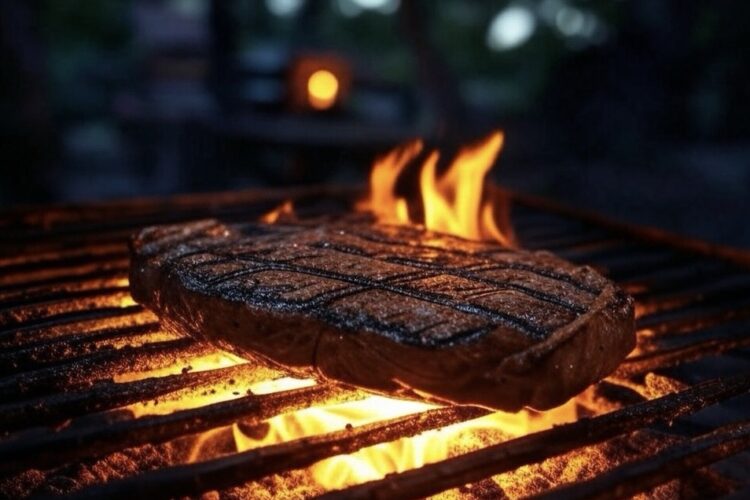Charred and burnt meat, prized for its smoky flavor from the Maillard reaction, poses health risks due to harmful compounds like polycyclic aromatic hydrocarbons (PAHs), heterocyclic amines (HCAs), acrylamide, and advanced glycation end-products (AGEs). These carcinogens, formed during high-temperature cooking like grilling, may increase cancer risk and cause oxidative stress. To enjoy grilled meat safely, use lower temperatures, marinate with herbs, trim fat, flip often, and avoid overcooking. Pair with vegetables to counter free radicals. Moderation and mindful cooking reduce toxins while preserving taste, making charred meat a safer indulgence.
Long Version
Charred and burnt meat, often celebrated for its smoky, robust flavor in barbecues and flame-grilled dishes, has sparked growing concern among health experts, chefs, and food safety advocates. While the allure of a perfectly blackened crust or the aroma of charcoal-grilled steak is undeniable, the implications of consuming overcooked meat—particularly when it’s carbonized or heavily charred—extend far beyond taste. This article delves into the science, health risks, culinary considerations, and practical solutions surrounding burnt meat, offering a thorough and authoritative resource on the subject.
The Culinary Appeal of Charred Meat
The allure of charred meat lies in the Maillard reaction, a chemical process that occurs when amino acids and sugars in food are heated, producing complex flavors and a golden-brown to blackened crust. This reaction is responsible for the savory, umami-rich taste that makes grilled or flame-grilled meat so appealing. For many, the slight char on a burger or the crispy edges of a barbecued rib represent the pinnacle of culinary artistry. However, when meat is overcooked to the point of being carbonized, the line between flavorful and hazardous begins to blur.
Charcoal grilling and high-temperature cooking methods, such as searing or broiling, amplify this effect. These techniques create a charred crust that enhances texture and flavor but also introduce chemical compounds that may pose health risks. While moderate charring is often intentional, excessive burning—resulting in blackened meat or carbonized residue—can degrade both nutritional value and safety.
The Science Behind Burnt Meat: Harmful Compounds
When meat is subjected to intense heat, especially during high-temperature cooking or flame-grilling, it undergoes pyrolysis, the thermal decomposition of organic material. This process generates several potentially harmful compounds, including:
Polycyclic Aromatic Hydrocarbons (PAHs)
PAHs form when fat and juices from meat drip onto an open flame or hot surface, causing smoke that deposits these compounds onto the food. Benzopyrene, a well-known PAH, is classified as a carcinogen by the World Health Organization (WHO). PAHs are linked to an increased risk of gastrointestinal cancer and other malignancies due to their ability to act as mutagens, damaging DNA.
Heterocyclic Amines (HCAs)
HCAs are produced when amino acids, sugars, and creatine in meat react at high temperatures, particularly during prolonged cooking. These compounds are also carcinogenic and have been associated with cancers of the colon, stomach, and pancreas. The formation of HCAs is most pronounced in overcooked meat, especially when it reaches a charred or blackened state.
Acrylamide
While more commonly associated with starchy foods like fries, acrylamide can form in meat cooked at extremely high temperatures. This compound, another potential carcinogen, contributes to the health concerns surrounding burnt meat.
Advanced Glycation End-Products (AGEs)
AGEs are formed when proteins or fats react with sugars under high heat, contributing to oxidative stress and inflammation in the body. These compounds, prevalent in charred meat, are implicated in chronic diseases such as diabetes and cardiovascular issues.
Lipid Oxidation and Free Radicals
High heat causes lipid oxidation, breaking down fats in meat and producing free radicals. These unstable molecules can damage cells and contribute to oxidative stress, increasing the risk of chronic diseases over time.
The combination of these compounds—PAHs, HCAs, acrylamide, AGEs, and free radicals—makes burnt meat a potential source of toxins that may accumulate in the body with repeated exposure. While occasional consumption is unlikely to cause immediate harm, frequent intake of charred or overcooked meat may elevate cancer risk and other health issues.
Health Risks of Consuming Charred and Burnt Meat
The primary concern with charred and burnt meat is its association with carcinogens. Studies, including those from the National Cancer Institute, suggest that diets high in grilled meat cooked at high temperatures correlate with an increased risk of cancers, particularly gastrointestinal cancer. The mutagens in HCAs and PAHs can initiate or promote tumor growth by altering DNA, while AGEs and free radicals contribute to systemic inflammation and cellular damage.
Beyond cancer, burnt meat may lose nutritional value due to protein denaturation, where excessive heat alters the structure of proteins, reducing their bioavailability. Additionally, carbonized residue can be difficult to digest, potentially irritating the gastrointestinal tract. For individuals with pre-existing conditions like diabetes or heart disease, the oxidative stress from AGEs and lipid oxidation may exacerbate their symptoms.
It’s worth noting that the risk depends on frequency and portion size. Occasional consumption of charred meat is unlikely to pose significant harm, but a diet consistently high in flame-grilled or overcooked meat—especially without balancing factors like vegetables or antioxidants—may amplify these risks over time.
Culinary Considerations: Balancing Flavor and Safety
From a culinary perspective, achieving the perfect balance between flavor and safety is key. Charred meat can elevate a dish, but blackened or carbonized meat often tastes bitter and acrid, detracting from the dining experience. Chefs and home cooks alike must navigate the fine line between intentional charring and culinary mistakes that produce harmful compounds.
Cooking Methods to Reduce Risks
To enjoy the flavors of grilled meat while minimizing health risks, consider the following strategies:
- Lower Cooking Temperatures: Opt for low-temperature cooking methods, such as baking or slow-roasting, to reduce the formation of HCAs and PAHs. If grilling, use indirect heat to avoid direct exposure to flames.
- Marinate Meat: Marinades containing herbs, spices, or acidic ingredients (like vinegar or citrus) can inhibit the formation of carcinogens. Rosemary, for example, contains antioxidants that counteract free radicals.
- Trim Fat: Removing excess fat before cooking reduces drippings that produce PAHs when they hit the flame.
- Flip Frequently: Turning meat often during grilling minimizes charring and ensures even cooking.
- Avoid Overcooking: Use a meat thermometer to cook meat to safe internal temperatures without reaching the carbonized stage. For example, cook beef to 145°F (medium-rare) or 160°F (medium) rather than well-done.
- Clean the Grill: Remove carbonized residue from grill grates to prevent transferring harmful compounds to food.
- Incorporate Vegetables: Pair grilled meat with antioxidant-rich vegetables like bell peppers or broccoli, which may help neutralize free radicals and reduce oxidative stress.
Alternative Cooking Methods
For those concerned about the risks of charred meat, alternative methods like sous-vide, steaming, or poaching preserve flavor and nutrition without exposing food to high heat. Smoked meat, while flavorful, should also be consumed in moderation, as the smoking process can introduce PAHs similar to grilling.
Food Safety and Practical Tips
Food safety is a critical consideration when preparing meat. Overcooked meat not only poses health risks but can also harbor bacteria if improperly handled before cooking. Ensure raw meat is stored at safe temperatures (below 40°F) and cooked to the appropriate internal temperature to eliminate pathogens without burning.
If you accidentally burn meat, trim away blackened or carbonized portions before consuming. While this won’t eliminate all carcinogens, it can reduce exposure to the most heavily affected areas. Additionally, avoid scraping charred crust into sauces or gravies, as this can transfer harmful compounds.
Cultural and Dietary Context
The consumption of charred or grilled meat varies across cultures. In the United States, barbecue and charcoal grilling are staples of summer gatherings, while in South America, asado (grilled meat) is a cultural cornerstone. In contrast, some cuisines prioritize low-temperature cooking or plant-based diets, reducing reliance on high-temperature cooking. Understanding these cultural differences can inform healthier adaptations of traditional dishes, such as using marinades or incorporating more vegetables into barbecue menus.
For individuals following specific diets—such as ketogenic or paleo—grilled meat is often a staple. These diets can still be safe if cooks prioritize food quality and avoid overcooking. Plant-based diets, meanwhile, eliminate the risks of charred meat entirely, though they may miss out on the flavors of the Maillard reaction.
Conclusion: Making Informed Choices
Charred and burnt meat occupy a complex space in the culinary and health worlds. The Maillard reaction and flame-grilled flavors are undeniably appealing, but the formation of carcinogens like PAHs, HCAs, acrylamide, and AGEs raises legitimate concerns about long-term health. By understanding the science behind high-temperature cooking, adopting safer cooking methods, and balancing grilled meat with nutrient-rich foods, you can enjoy the best of both worlds: bold flavors and better health.
Whether you’re a barbecue enthusiast or an occasional griller, the key is moderation and mindfulness. Trim carbonized residue, marinate generously, and embrace techniques that minimize toxins without sacrificing taste. By making informed choices, you can savor the smoky allure of charred meat while safeguarding your well-being.
Hashtags For Social Media
#charredmeatrisks #burntmeatdangers #grillinghazards #overcookedmeat #charredfoodrisks #bbqsafety #meatcookingtips #grillhealth #foodsafety #healthygrilling #carcinogensinfo #grillrisks #meathealth #cookingmeat #charredflesh #grillingmistakes #foodhealth #safegrilling #burntfoodrisks #meatsafety #healthycooking #grilldangers #foodprep #cookinghazards #meatloverhealth #bbqtips #grillmaster #foodwarnings #healthymeat #cookingrisks
Related Questions, Words, Phrases
what are the dangers of charred meat | is charred meat bad for you | health risks of eating charred meat | why is charred meat risky | can charred meat cause cancer | what happens when you eat charred meat | risks of overcooked meat | is grilled meat harmful | charred meat and health concerns | does charred meat increase cancer risk | how dangerous is eating charred meat | health effects of charred meat consumption | why avoid charred meat | is it safe to eat charred meat | charred meat safety concerns | what are the side effects of charred meat | can eating charred meat be harmful | risks associated with charred meat | how does charred meat affect health | is charred meat linked to diseases | dangers of cooking meat until charred | health hazards of charred meat | what chemicals are in charred meat | does charred meat contain carcinogens | risks of eating blackened meat | why is charred meat unhealthy | can charred meat cause health problems | effects of eating charred meat regularly | is charred meat toxic | health risks of grilling meat to charred | what are the long-term risks of charred meat | how to avoid risks from charred meat | is eating charred meat dangerous for kids | does charred meat cause inflammation | why does charred meat pose health risks






